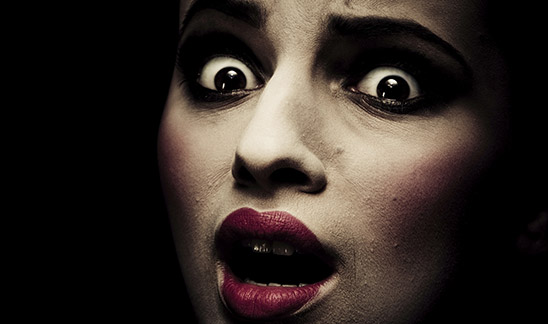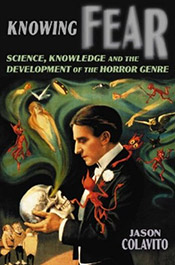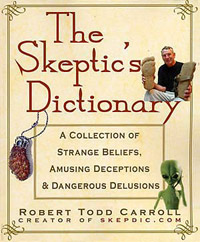Do depictions of the supernatural on television and in movies lead to belief in pseudoscience and the paranormal? Or, is there something more subtle happening within these shows that we should pay attention to? In this week’s eSkeptic, Jason Colavito tells us why skeptics should embrace the supernatural on television.
Jason Colavito is a freelance writer based in Albany, NY. His most recent book is Knowing Fear: Science, Knowledge, and the Development of the Horror Genre.

Oh, the Horror!
Why Skeptics Should Embrace
the Supernatural on Television
by Jason Colavito
For as long as there have been stories of the supernatural, some who heard them believed that the menacing creatures depicted in them really existed. There have also always been skeptics who doubted the reality of the supernatural monsters. Mythological creatures like satyrs and centaurs were once thought to live in the uncharted forests beyond civilization’s reach. Ghosts have been a continuous presence in humanity’s imaginary lives, and even today fictional creatures like Bigfoot, the Loch Ness monster, and space aliens in flying saucers have their die-hard adherents.
These stories were told and retold as non-fiction, but at the end of the Enlightenment a new type of fiction emerged: the tale of supernatural terror. Unlike the purveyors of myths and legends, the authors of these stories knew they were writing fiction. Critics, though, claimed such stories were dangerous, especially for women and children, who may come to believe in superstitious claims. In 1833 one writer claimed:
Those fictious [sic] narratives so commonly told in nurseries, called ghost stories, or other horrible recitals of the same kind, are decidedly injurious under all circumstances. I know that children in the habit of hearing these follies, grow up fearful, and in some measure in want of moral courage; they become more or less superstitious, and lack resolution; a person, however strong in mind naturally, cannot wholly divest himself of the paralyzing effect of these injurious influences inculcated in his youthful days, even when he attains mature age.1
This righteous indignation continues today, with skeptics and scientists arguing that depictions of the supernatural on television and in movies lead to belief in pseudoscience and the paranormal. For example, Skeptic Dictionary editor Robert Todd Carroll attributes the prevalence of the belief that ghosts communicate through tape recorders, radios, and televisions to the 2005 movie White Noise. Science writer Chris Mooney complained that television programs with supernatural themes “shill for religion and the paranormal,” while science journalist Matt Nisbet argued that science fiction and fantasy films “attack reason, sell transcendental fantasies, and undermine appreciation for science and progress.” There is frequent concern for the welfare of children, as when the science communication expert Glenn Sparks reported that supernatural-themed television was especially dangerous for teenagers.2
The horror genre, however, is more than a vehicle for reproducing superstition. A brief examination of the origins and development of the horror genre before World War II demonstrates that supernatural horror transcends simple-minded repudiations of science and is, in fact, a subtle and important critique of science and rationalism, one that skeptics can benefit from by approaching it with an open mind.
Origins
Gothic horror is the name usually given to a group of novels and stories composed between 1764 and 1820 that used supernatural elements and spooky settings to generate an atmosphere of terror. The first Gothic novel was Horace Walpole’s 1764 The Castle of Otranto, the story of a usurper whose control of his domain is undone by the appearance of a powerful ghost. Other well-known works of Gothic horror include Ann Radcliffe’s 1794 The Mysteries of Udolpho, Matthew Lewis’s 1796 The Monk, and of course the 1818 classic by Mary Shelley, Frankenstein.
item of interest…
Based on Carroll’s website (skepdic.com), the Dictionary is the definitive short-answer debunking of nearly every thing skeptical. A must for every bookshelf.
ORDER the book
These novels, and countless others like them, were products of the Romantic Movement, the great backlash against the rationalism of the Enlightenment. Whether consciously or unconsciously, Gothic writers turned to the supernatural as a critique of rationalism and an expression of the emotional truths the Romantics sought to explore. However, Gothic horror had a suitably rational basis, provided by the statesman and philosopher Edmund Burke. In his widely read and influential 1756 work A Philosophic Enquiry into the Origin of Our Ideas of the Sublime and Beautiful, Burke had laid down the aesthetic basis for the horror genre, arguing that fear was the quickest and most direct way of experiencing the sublime:
No passion so effectually robs the mind of all its powers of acting and reasoning as fear. … Whatever therefore is terrible, with regard to sight, is sublime too, whether this cause of terrour be endued with greatness of dimensions or not. … Indeed, terrour is in all cases whatsoever, either more openly or latently, the ruling principle of the sublime.3
For writers like Walpole or Lewis, the supernatural was a way of reaching the sublime by purposely employing concepts that could serve no other useful purpose. When critics attacked Lewis’s ghostly 1797 play The Castle Spectre for depicting a ghost where the common folk could see it, Lewis responded with an angry afterward to the published text of the play:
Against my Spectre many objections have been urged: one of them I think rather curious. She ought not to appear, because the belief in Ghosts no longer exists! In my opinion, that is the very reason why she may be produced without danger; for there is now no fear of increasing the influence of superstition, or strengthening the prejudices of the weak-minded.4
In other words, educated audiences knew ghosts are not real, so their use was to represent the irrational and the emotional — to be symbols, and to be fun. Ann Radcliffe took a different path and ended her works with a revelation that the alleged “ghost” in the story was the product of human or natural agency. However, as belief in ghosts and the supernatural became more widespread among the middle and upper classes during the 19th century, horror fiction responded in ways interesting and relevant to skeptics and historians of science.
Skeptics & Believers in Fact & Fiction
During the 19th century, many scholars and critics agreed that belief in ghosts was widespread and something needed to be done about it. In 1823 the publisher Rudolph Ackermann produced a series of didactic short stories under the title Ghost Stories: Collected with Particular View to Counteract the Vulgar Belief in Ghosts and Apparitions, and to Promote a Rational Estimate of the Nature of Phenomena Commonly Considered as Supernatural. These stories revealed natural or human explanations for the ghosts, as Ackermann explained:
The best way to dissipate the inbred horror of supernatural phantoms, which almost all persons derive from nursery tales or other sources of causeless terror in early life, is to show by example how possible it is to impress upon ignorant or credulous persons the firm belief that they behold a ghost, when in point of fact no ghost is there.5
Two decades later, Catherine Crowe’s 1848 The Night-Side of Nature did just the reverse, presenting ghost stories of dubious quality as true-life accounts of the supernatural. The book is frequently credited with helping spark the rage for Spiritualism, the belief that the shades of the dead can be contacted by mediums who communicate with the spirit realm. Scientists and believers clashed over the reality of the supernatural, and the debate extended into horror fiction.
One of the earliest examples of this was Sir Walter Scott’s 1828 “The Tapestried Chamber,” which became the template for the Victorian ghost story. In it, a “complete sceptic” puts up a soldier in a haunted room, where the soldier experiences an apparition of the ghost, converting the skeptic to belief in the supernatural when faced with this evidence.
From this story forward, few ghost stories, or horror stories of any kind, would be complete without the requisite skeptic who stood by, ready for conversion, or what the satirical magazine Punch once called the “the Inquiring, Sceptical, Incredulous Noodle” who “must never be absent from the dramatis personæ” of the horror story.6 Such Noodles could be found everywhere: in Fitz-James O’Brien’s 1859 “What Was It?,” Bram Stoker’s 1897 Dracula, in Robert Hichens’s 1900 “How Love Came to Professor Guildea,” and in the scientist-scholar heroes of Arthur Machen, Algernon Blackwood, and H. P. Lovecraft.
Though it goes without saying that in these tales of horror the skeptic is confronted with supernatural or other entities that extend beyond the limits of known science, it is not a foregone conclusion that these stories promote belief in the supernatural, as a cursory reading might suggest. Instead, there is something more subtle happening here, as a few examples will show.
In many stories, the character of the skeptic represents close-minded dogmatism rather than true scientific inquiry, the truth of which is taken for granted. In Dracula, Dr. John Seward is a man of science, but he is powerless before the forces of the title vampire because his materialist philosophy has blinded him to the evidence of the reality of the supernatural. By contrast, his mentor, Prof. Abraham Van Helsing, pursues the evidence where it leads, even into the darkened corners of the apparent supernatural. Far from repudiating science, Dracula supports the workings of science as Van Helsing struggles to understand the new phenomenon (the vampire), test theories, and reach conclusions. Only this non-dogmatic, open science can stop the vampire menace via free inquiry and experimentation.
Similarly, in “How Love Came to Professor Guildea” the skeptical scientist Guildea comes to embrace the supernatural — but not because he has been indoctrinated by Spiritualist true-believers. The story tells of a man of science besieged by an unseen entity that drives him to madness and death. His belief in the ghost, though, stems from scientific observation of one living in his own house, the reality of which he proves by ruling out all possible naturalistic explanations. Here, though, the story’s author, Robert Hichens, offers a special critique of science. While Guildea is a rational, emotionless scientist, the ghost is that of a mentally-impaired individual, devoid of reason and possessed only of emotion. In other words, symbolically Victorian science was being haunted by the Romantic irrational.
The scientist-scholars found in H. P. Lovecraft’s body of short stories and novellas (the so-called “Cthulhu Mythos”) represent the apex of the horror story’s battle between skeptic and believer. In Lovecraft, skeptics doubt the existence of the “Old Ones,” titanic, monstrous gods from prehistory which devoted cults still worship in secret. The heroes dismiss the old legends as ignorant hearsay and myth, but they discover the ultimate reality of these beings, which are in fact extraterrestrials who came to earth billions of years ago, part and parcel of a materialist, mindless cosmos both grander and more indifferent to humanity than anyone could imagine. Once again, the implicit critique of science is not opposition to its methods but to the perception of science as dogmatism and doctrine.
Conclusion
Of course, a great deal of supernatural fiction is and has always been hackwork, but as I have tried to show, a significant portion of it offers a critique (not a repudiation) of science. Once seen in this light, horror literature takes on new meanings for skeptics and scientists. The message is not always what we skeptics want to hear, but we would do well to actively engage in a deeper reading of the themes and symbols present in supernatural fiction before attacking it for “injurious influences” on its audience.
References
- Rendle, W. 1833. “On the Moral Education of Youth.” The Imperial Magazine, May, 219.
-
Carroll, Robert Todd. 2007. “Electronic Voice Phenomenon.” Skeptic’s Dictionary. Online article: www.skepdic.com/evp.html;
Mooney, Chris 2005. “Less Than Miraculous,” CSICOP Online, May 25. Online article: www.csicop.org/doubtandabout/paratv/;
Nisbet, Matt. 1999. “The Phantom Menace of Superstition in Film and Television,” SI Digest, May 27. Online article: www.csicop.org/articles/19990527-starwars/;
“Professor: TV Shows May Tune Our Belief in the Supernatural.” 2005. AScribe Newswire, September 6. Online article: www.ascribe.org/cgi-bin/behold.pl?ascribeid=20050906.135843&time=14%2034%20PDT&year=2005&public=1.
- Burke, Edmund. 1834. The Works of the Right Hon. Edmund Burke. vol. 1. London: Holdsworth and Ball, 38.
- Lewis, Matthew Gregory. 2000. “Postscript to The Castle Spectre.” In Clery, E. J. and Miles, Robert (eds.), Gothic Documents: A Sourcebook 1700–1820. Manchester: Manchester University Press, 198.
- Ackermann, Rudolph. 1846. Ghost Stories: Collected with Particular View to Counteract the Vulgar Belief in Ghosts and Apparitions. Philadelphia: Carey and Hart, 6.
- B. W., Baron de. 1897. “Our Booking Office.” Punch, June 26, 327.











